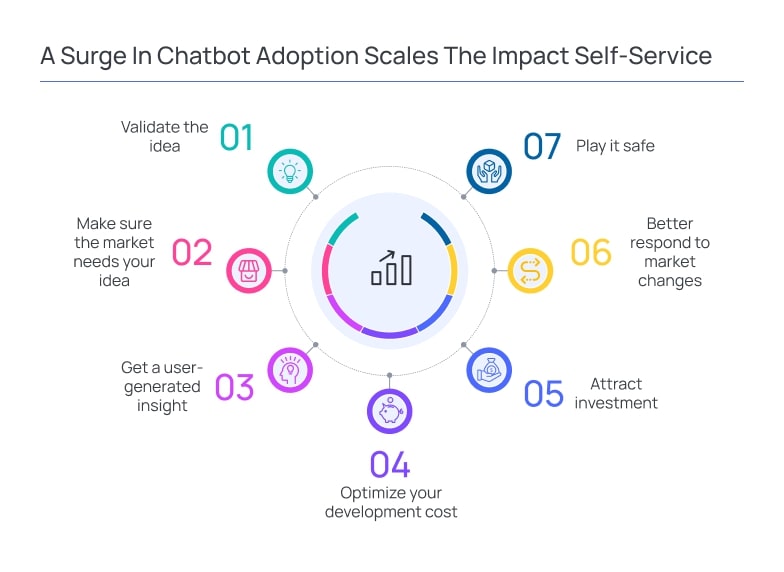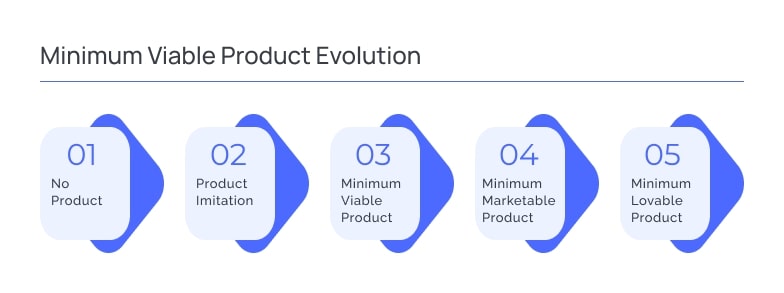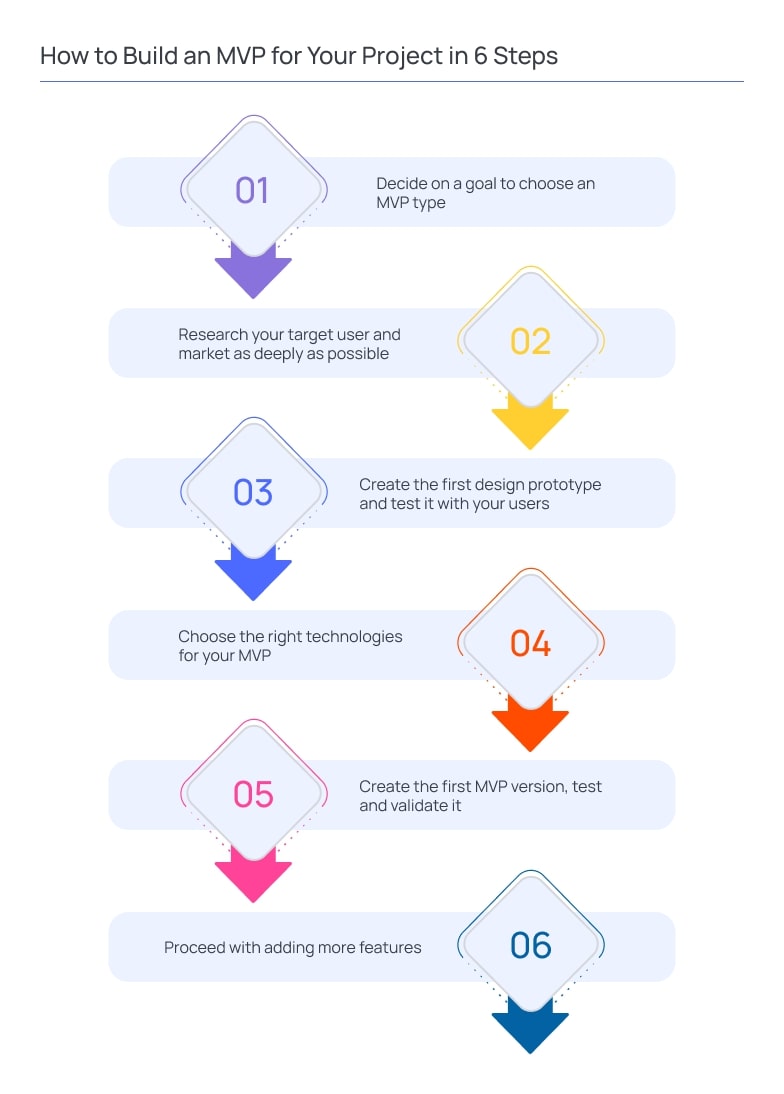While there is no way to be 100% sure of your future app success, there is still a way to develop as a winning tech product as possible. There are a lot of the best startup development practices, and developing an MVP for a startup app is one of them. Despite the seeming simplicity of an MVP concept, you have to be smart when creating it, making data-driven decisions, validating each of the hypotheses, and staying tuned to your users’ feedback.
Let’s find out how to create an MVP for a startup to leverage its full potential for your future business.
Minimum Viable Product (MVP) Definition
The concept of a Minimum Viable Product isn’t new. As the name suggests, this is a pretty basic version of a future application that comes with the core set of features only but it is still able to solve the users’ problem. The concept of an MVP was firstly introduced by Eric Ries in 2011, and to date, it is at the heart of any development process.
What’s more, some experts refer to MVP as not to the end or intermediate result. They refer to it as the process of a startup evolution meaning that the project matures with each new feature being added and with every practical insight learned. This is just the point where the concept of an MVP means LEAN and Agile development methodology. While the first stands for never-ending research, discovery, and learning, the second promotes the development process flexibility, instant response to market changes, and careful tailoring of the future solution to the target audience’s needs.
MVP Business Benefits
Below are the benefits of an MVP for your startup. While some of them can be pretty valuable right now, creating an MVP can also deliver benefits in the long run, so let’s review them in more detail.

- Validate the idea. Once upon a time, each great startup began as an idea. Still, the idea alone isn’t enough to make sure that it will work as you expect it to work, being demanded by the market and adopted by the users. Creating an MVP is the first step towards making sure you are on the right track since it allows for validating the idea without the need to create a full-fledged product and invest in it. What’s more, there are some completely free idea validation practices – and we will share them a little later.
- Make sure the market needs your idea. Most of the startups fail because the market doesn’t need them. Developing a startup MVP is the opportunity to find out, check and test the real market response, at significantly lower costs than launching a fully ready solution. What’s more, MVP development goes hand in hand with research and discovery which allows for suggesting even more winning ideas right on the go.
- Get a user-generated insight. One of the core ideas behind MVP development for tech startups is the necessity to constantly test your product and carefully listen to the opinion of your users. This is just the case when the user decides what you should develop to meet their needs, and MVP gives you an opportunity to uncover the true desires of your target audience firsthand.
- Optimize your development cost. Building MVP for startups protects you from both investing in the solution the market will abandon and in building the features you users don’t actually need. To put it simply, startup MVP development is a path of cost optimization since this tactic encourages you to learn, test, and only then, invest.
- Attract investment. The innovative projects willing to attract investments are also welcome to create a minimum viable product. Showcasing it to the investors significantly increases the chances of getting funded since your MVP is living proof that: a) your idea works; b) your solution solves the problem; c) the users are likely to adopt it. Compared with a bare idea, an MVP is a more winning option to attract investments since you already have a lot to show, in addition to the sales pitch and business plan.
- Better respond to market changes. Most modern applications are being developed in an uncertain market environment. Even the ultimately deep market research isn’t a guarantee that there will be no sudden changes tomorrow. Following the path of an MVP, development allows you to be more flexible with your product, adjust it on the go, and better meet the changing users’ preferences.
- Play it safe. Generally, creating an MVP protects your business from making hasty decisions and wasting the development budget. It is also promises an opportunity to better research the market and target users, tailoring your future solution to their expectations as carefully as possible. MVP development for startups is an ever-free and win-win strategy that is always better to follow regardless of the development methodology, market specifics, and the budget available.
Ready to get all these benefits for your project?
Create an MVPMVP Types

The concept of an MVP is pretty flexible – it allows you to get started with your idea validation at no or almost no cost, and grow step by step, testing new (but still market-suggested) hypotheses and evaluating their business value.
Below are the main types of a Minimum Viable Product you can create for your business.
- No Product. Sometimes, you don’t need a product itself to test its market need, and this is relevant for both digital and physical products. For example, you can evaluate the market response for your future project by creating a simple landing page and running PPC ads. This simple and low-cost tactic allows you to make sure there is an actual interest in your offer, plus you can test a landing page as a marketing tool.
- Product Imitation. This type of MVP is more difficult to create since this is a kind of prototype of a future solution. The imitated applications, as a rule, allow the focus group users to interact with them but use raw and random data called via APIs.
- Minimum Viable Product. This is already a demo version of your future solution. Usually, it comes with a core feature to demonstrate how the product solves the users’ needs.
- Minimum Marketable Product. An MMP is the next stage in the MVP evolution – this type of app is quite ready to be advertised and sold to the target audience since the value it delivers is already confirmed at the stage of MVP testing.
- Minimum Lovable Product. MLP is the solution that users love and recommend. This is almost the final stage of startup development since all the features that will be added in the future are the response to either growing or changing users’ demands.
Ready to work along the startup evolution path?
Let Us Support YouHow to Build an MVP for Your Project in 6 Steps

So, let’s create an MVP for a startup step by step, following the pitfalls-free tactic.
1. Decide on a goal to choose an MVP type
While MVP development comes with a lot of business benefits, it is still better to tailor it to the specific goal before getting started with its creation. For example, if your goal is to practically find out whether there is a demand for your product or service, you can proceed with a No Product MVP. This tactic is also better suitable for physical products or services. But if you want to attract investments on the crowdfunding platform and fund your tech solution development, it is better to get started with creating a prototype at least.
2. Research your target user and market as deeply as possible
One of the best things about creating an MVP for your product is that it allows you to stay tuned into the market trends and user behavior patterns 24/7. Still, you have to carefully understand what you are going to create and who will use it. So, get started with in-depth market research and target audience discovery.
As for the latter, asking in-advance questions to your users never harms. Consider getting in touch with a focus group and running a survey, discovering their opinion about the solutions they use and the features they lack. Use these data-driven insights as your MVP development guideline.
3. Create the first design prototype and test it with your users
The first prototype you can create shouldn’t necessarily be coded. You can come up with it using even a simple piece of paper or an online prototyping tool like Miro. Next, ask your focus group to share the impressions, track their behavior patterns with the help of hot mapping, ask them about visual design impressions and the convenience of the UI. Then, improve the prototype accordingly.
4. Choose the right technologies for your MVP
Creating a testable and validatable MVP is essential for getting most of the benefits out of it. That’s why you have chosen the right tech stack to develop the first Minimum Viable Product version. The technologies you have to choose are largely determined by your users’ preferences. For example, if you plan to create a mobile app, and the majority of the target audience uses iOS, then, the choice of the platforms becomes obvious.
As a time and money-saving tip, you can also consider creating a cross-platform MVP. It is still capable of delivering a close-to-native app usage experience but it is easier and more affordable to build. What’s more, cross-platform MVPs are easy to transform into full-fledged native products.
5. Create the first MVP version, test and validate it
After your first MVP is ready, run test sessions with the users. You can test it in the way you have tested your first prototype but be even more careful at this stage. Make sure to ask the right questions, analyze their behavior patterns, and focus on both strengths and weaknesses of your solution.
6. Proceed with adding more features
Since MVP development is more about a process than a final result, at this stage, you will have to add more features, suggested by your users and validated one more time. Grow your application to a Minimum Marketable one, transform it into a Minimum Lovable Product, and still stay tuned to the user’ generated insights.
The Cost to Create an MVP
The matter is that the MVP development cost is very fluctuating. You can get started with both $50 and $50,000 in your pocket. In the first case, you will be able to run a landing page test and confirm or reject the hypothesis. In the second case, you will be able to create a powerful Minimum Viable Product that is likely to have a few features to add. Long story short, it all depends on your goals, while the path of LEAN development protects you from making unwise investments at every step.
Indeed, there is a thing that can be said for sure – the cost of the MVP development services for startups per hour is pretty different depending on the MVP development company location. The price gap for services of the same quality can be very significant, so consider running a lean project from the very beginning. Software development teams from Ukraine can offer you top-notch code quality combined with the best business practices delivered at a reasonable cost.
Conclusion
Creating an MVP for your startup is essential for protecting your business from costly mistakes, making validated and smart decisions, creating the solution the market will actually need, and fitting the users’ expectations. While there are a lot of ways to validate some of the hypotheses even for free, most startups face the need for stronger tech expertise when it comes to creating an MVP itself. Binerals is a software development company well-versed in the best business and tech practices to create an effective MVP, perfectly aligned with your business goals and your future users’ demands.
Let’s discuss your idea and highlight the first steps to give it a way.
Request an NDA